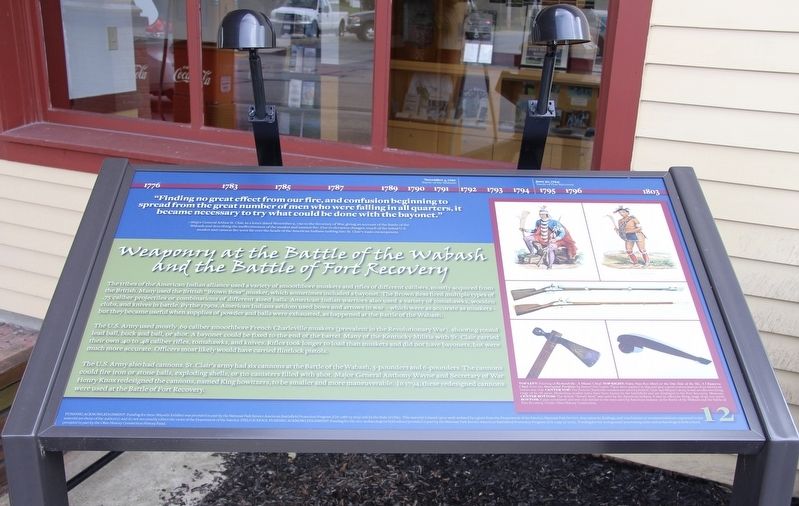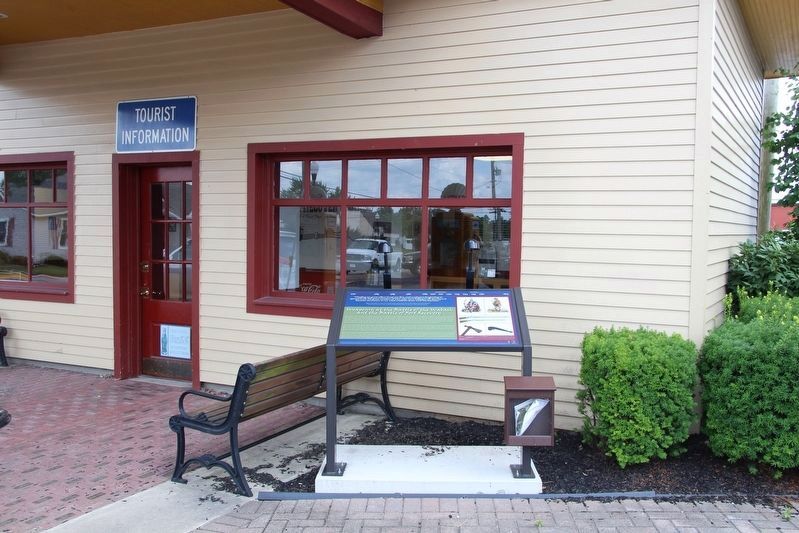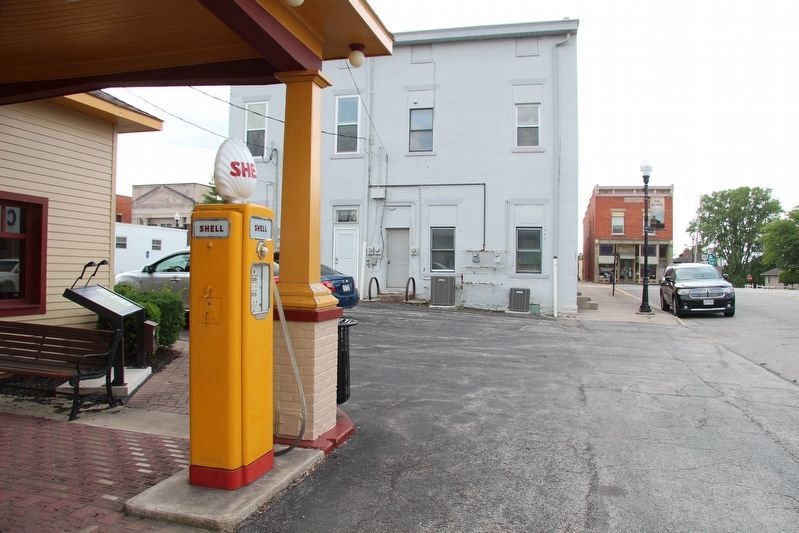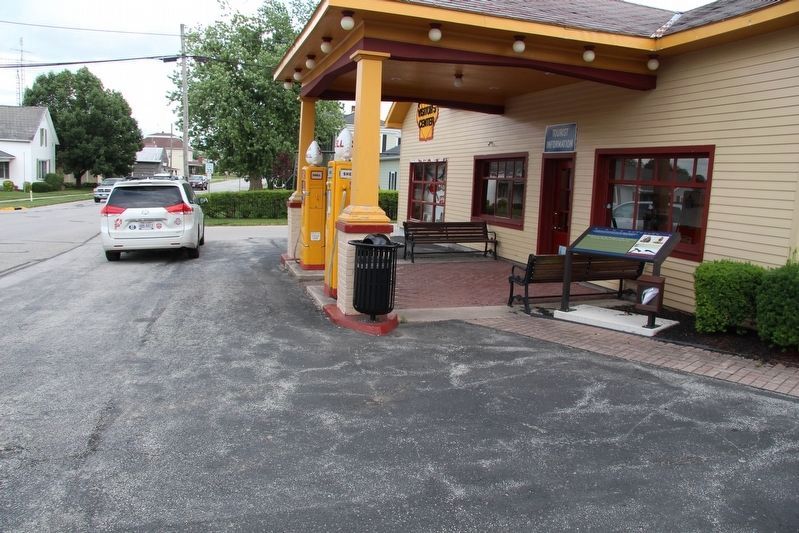Fort Recovery in Mercer County, Ohio — The American Midwest (Great Lakes)
Weaponry at the Battle of the Wabash and the Battle of Fort Recovery
Inscription.
"Finding no great effect from our fire, and confusion beginning to
spread from the great number of men who were falling in all quarters, it
became necessary to try what could be done with the bayonet."
--Major General Arthur St. Clair, in a letter dated November 9, 1791 to the Secretary of War, giving an account of the Battle of the Wabash and describing the ineffectiveness of the musket and cannon fire. Due to elevation changes, much of the initial U.S musket and cannon fire went far over the heads of the American Indians rushing into St. Clair''s main encampment.
The tribes of the American Indian alliance used a variety of smoothbore muskets and rifles of different calibers, mostly acquired from the British. Many used the British "Brown Bess” musket, which sometimes included a bayonet. The Brown Bess fired multiple types of .75 caliber projectiles or combinations of different sized balls. American Indian warriors also used a variety of tomahawks, wooden clubs, and knives in battle. By the 1790s, American Indians seldom used bows and arrows in war-which were as accurate as muskets but they became useful when supplies of powder and balls were exhausted, as happened at the Battle of the Wabash.
The U.S. Army used mostly .69 caliber smoothbore French Charleville muskets (prevalent in the Revolutionary War), shooting round lead ball, buck and ball, or shot. A bayonet could be fixed to the end of the barrel. Many of the Kentucky Militia with St. Clair carried their own .40 to .48 caliber rifles, tomahawks, and knives. Rifles took longer to load than muskets and did not have bayonets, but were much more accurate. Officers most likely would have carried flintlock pistols.
The U.S.Army also had cannons. St. Clair''s army had six cannons at the Battle of the Wabash, 3-pounders and 6-pounders. The cannons could fire iron or stone balls, exploding shells, or tin canisters filled with shot. Major General Anthony Wayne and Secretary of War Henry Knox redesigned the cannons, named King howitzers, to be smaller and more maneuverable. In 1794, these redesigned cannons were used at the Battle of Fort Recovery.
Erected by National Park Service American Battlefield Protection Program and the State of Ohio. (Marker Number 12.)
Topics. This historical marker is listed in these topic lists: Forts and Castles • Native Americans • Wars, US Indian. A significant historical date for this entry is November 9, 1791.
Location. 40° 24.841′ N, 84° 46.735′ W. Marker is in Fort Recovery, Ohio, in Mercer County. Marker is on East Boundary Street east of Wayne Street, on the right when
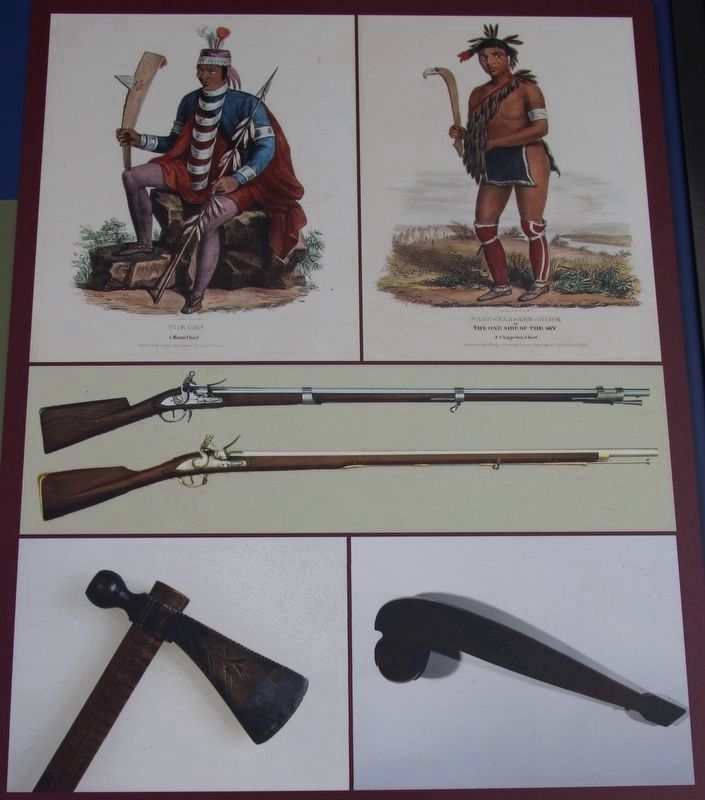
Photographed By Dale K. Benington, July 15, 2019
2. Weaponry at the Battle of the Wabash and the Battle of Fort Recovery Marker
Close-up view of several features that are displayed on this marker. The captions read as follows: Top Left: Painting of Richardville; A Miami Chief; Top Right: Nabu-Naa-Kee-Shick or the One Side of the Sky, A Chippewa Chief, from the Aboriginal Portfolio by James Otto Lewis. These were painted in 1835 and give a good representation of an American Indian war club. Center Top: The French Charleville musket was used by both St.Clair and Wayne's army. It had an effective firing range of 60-76 yards. Numerous musket parts have been found on the battlefield and are displayed in the Fort Recovery Museum. Center Bottom: The British "Brown Bess” was used by the American Indians. It had an effective firing range of 50-100 yards. Bottom: A pipe tomahawk and war club similar to the ones used by American Indians at the Battle of the Wabash and the Battle of Fort Recovery. Credit: Ohio History Connection.
Other nearby markers. At least 8 other markers are within walking distance of this marker. The Battle of Fort Recovery (within shouting distance of this marker); Building Fort Recovery (within shouting distance of this marker); a different marker also named Battle of Fort Recovery (within shouting distance of this marker); Locating the Fort (within shouting distance of this marker); The Battle of the Wabash (within shouting distance of this marker); 114-116 North Wayne Street (within shouting distance of this marker); The Role of Women in the Battle (about 300 feet away, measured in a direct line); Welcome To Historic Fort Recovery (about 300 feet away). Touch for a list and map of all markers in Fort Recovery.
Credits. This page was last revised on January 30, 2023. It was originally submitted on August 4, 2019, by Dale K. Benington of Toledo, Ohio. This page has been viewed 487 times since then and 45 times this year. Photos: 1, 2, 3, 4, 5. submitted on August 4, 2019, by Dale K. Benington of Toledo, Ohio.
